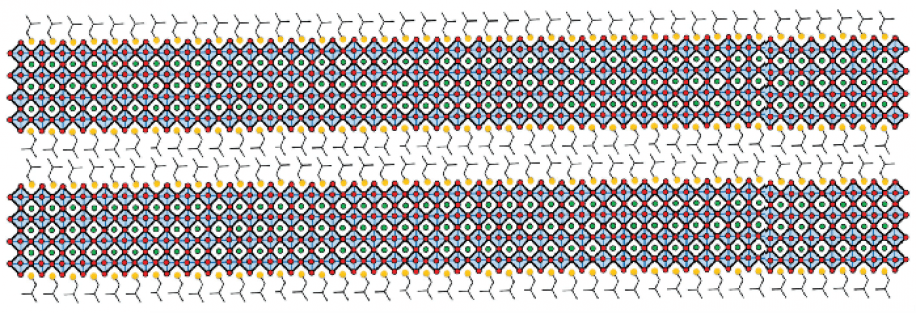May 24 2017
A collaborative team of Researchers from Lund University in Sweden and from Fudan University in China have been successful in designing a new structural organization using the potential solar cell material perovskite. The study reveals that solar cells increase in efficiency because of the ability of the material to self-organize by standing on edge.
 The illustration shows sheets of perovskite, side view. The colored pattern represents perovskite and the grey lines symbolize the water-repelling surfaces. (Credit: Lund University)
The illustration shows sheets of perovskite, side view. The colored pattern represents perovskite and the grey lines symbolize the water-repelling surfaces. (Credit: Lund University)
Perovskite is a new and promising material in relation to solar cells. However, in its basic form, the material is highly sensitive to moisture. It just dissolves when it is in contact with water, and even regular humidity weakens the material within hours or minutes. Now, this Research team seems to have overcome that challenge.
We have succeeded in producing thin sheets with a water-repelling surface, making the whole construction much more stable. In addition, we have succeeded in orienting the sheets so as to obtain acceptable solar cells, with an efficiency of ten per cent.
Tönu Pullerits, Professor of Chemical Physics, Lund University
Tönu Pullerits envisions immense development potential for perovskite-based solar cells, because of the results of the current study. The Researchers not only developed thin sheets out of the material to attain water-repelling surfaces but also found, to their surprise, that these perovskite sheets self-organized in a way that unmistakably increased efficiency.
As the sheets are very thin, they have to be layered on top of each other so that the absorption of sunlight is sufficient. There is a problem at this stage. The water-repelling surfaces do not allow electrons to flow freely within the material. It becomes hard for the electrons to jump from one sheet to another, which decreases efficiency in the solar cells.
The Researchers initially tested two diverse water-repelling surfaces. They anticipated that the first version would provide better results, allowing the electrons to jump more easily from one sheet to the next. Instead, the result was the opposite – the second version provided much better results. The Researchers were surprised and began to perform new experiments to understand why.
Here, our laser experiments were crucial. We could show that the sheets with the second surface material self-organised in such a way as to stand on edge instead of lying flat against one another.
Tönu Pullerits, Professor of Chemical Physics, Lund University
Due to the self-organizing structure of the sheets, the electrons were able to flow freely between the contacts, significantly raising the efficiency of converting the solar energy into electricity. Tönu Pullerits believes the result is an important step towards constructing stable and efficient solar cells out of perovskite.
Stability is a key issue for solar cells.
Tönu Pullerits, Professor of Chemical Physics, Lund University
The present study is a partnership between Lund University and Fudan University in Shanghai. Recently, the study was published in the Advanced Energy Materials journal.